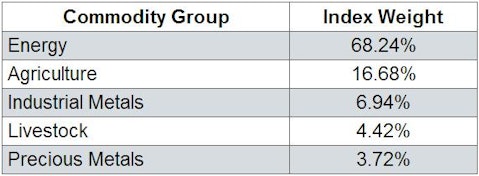The rapid development of the ETF industry has cracked the world of commodity investing wide-open, allowing average investors to gain cheap and easy access to a previously hard-to-reach asset class. And while some choose to focus on a single commodity, many investors are looking for morediversified exposure to the whole space. Enter iPath’s S&P GSCI Total Return Index ETN, GSP, one of the oldest commodity-basket ETPs on the market. Since inception in 2006, the fund has accumulated more than $113 million in total assets and remains as one of investors’ top picks for broad-based commodity investing [for more commodity ETF news and analysis subscribe to our free newsletter].
Although other “total” commodity ETPs are now available on the market, GSP still stands out with its product structure, portfolio composition, and the resulting unique risk/return profile. And considering how long this fund has been in existence, its resilience perhaps warrants a closer look from investors.
Vital Stats
Here’s a quick overview of the basics of GSP:
Issuer: Barclays iPath
Index: S&P GSCI Total Return Index
Number of Commodities: 24
Largest Allocation:Crude Oil (29.27%)
Inception Date: June 6, 2006
Expense Ratio: 0.75%
Assets: $113.3 million (as of 10/10/2012)
Structure: Exchange-Traded Note
Under The Hood
GSP seeks to replicate the S&P GSCI Total Return Index, offering exposure to 24 different commodity futures contracts. The index breakdown by commodity family is presented in the following table (as of 10/10/2012) :

GSP features allocations across all of the major segments of the commodity market, including exposure to energy, precious metals, agriculture, industrial metals, and livestock. However, GSP’s underlying portfolio is far from balanced; this ETN is heavily tilted towards energy commodities, which account for over two thirds of total assets [see Crude Oil Guide: Brent Vs. WTI, What’s The Difference?].
Noteworthy Features
Besides the hefty allocations to energy commodities, there are a few other aspects of GSP that are noteworthy. For starters, GSP is linked to the same index as GSG, however, its ETN product structure potentially makes it more appealing than its counterpart. While GSP is subject to the credit risk of the issuing institution since it is a senior debt instrument, its product structure still boasts several advantages over comparable ETFs. Unlike funds that trade futures contracts such as iShares S&P GSCI Commodity-Indexed (NYSEARCA:GSG) and the ultra-popular PowerShares DB Com Indx Trckng Fund (NYSEARCA:DBC), commodity ETNs will not require investors to fill out a K-1 at the end of the year. That means that there is no annual mark-to-market that spurs a taxable event, and shareholders of GSP have to record a loss or gain only upon sale, unlike shareholders of iShares S&P GSCI Commodity-Indexed (NYSEARCA:GSG) and PowerShares DB Com Indx Trckng Fund (NYSEARCA:DBC) who have to do so annually.
This advantageous feature gives investors more control over their tax liabilities, making the ETN product structure optimal for investors looking to add commodity exposure to their long-term, buy-and-hold portfolios. Investors should note that GSP is subject to contango, seeing as how there is no clear cut methodology outlined for the maturity dates used, unlike the one-of-a-kind USCI [seeCommodity ETF Spotlight: USCI In Focus].
How To Use
GSP is an intriguing product that bears favorable tax treatment and may be appropriate for some investors in certain circumstances. Despite these advantages, this ETN has a host of drawbacks that make it less than ideal as a well-diversified, core holding for long-term portfolios. When considering its underling portfolio, GSP may very well appeal to investors who are bullish on the energy sector. This ETN could be used as a tactical tool for investors who are bullish on energy prices but don’t necessarily want to go “all in” so to speak; in which case the minimal exposure to agricultural and industrial metals can serve as a nice cushion to smooth out the inherent volatility prominent across the energy commodities [see also Dividend Special: Four Commodity Stocks Yielding Over 5%].
This article was originally written by Daniela Pylypczak, and posted on CommodityHQ.




